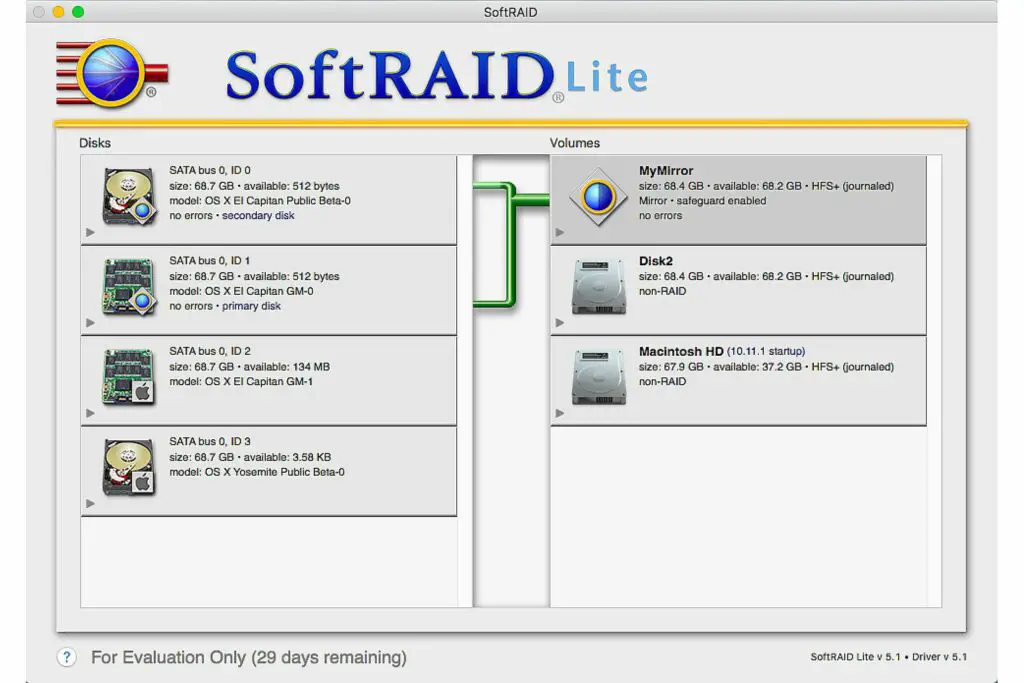

- #SOFTRAID LINUX HOW TO#
- #SOFTRAID LINUX DRIVER#
- #SOFTRAID LINUX SOFTWARE#
Sector size (logical/physical): 512B/512B parted -a optimal /dev/sdb print Model: ATA VBOX HARDDISK (scsi)
#SOFTRAID LINUX SOFTWARE#
Set the partition as software RAID partition. parted -a optimal /dev/sdb mkpart primary ext4 0% 100% Create the partition and set the filesystem type. Set the type of partition on the disk. In this demo, we use parted command for this purpose. In order to use a disk as RAID disk, you need to create a RAID partition type on each disk. In our demo server, we already have attached two disks, /dev/sdb and /dev/sdc each of 4GB as shown below lsblk NAME MAJ:MIN RM SIZE RO TYPE MOUNTPOINT To setup RAID Level 1, you need at least two drives/partitions. #SOFTRAID LINUX HOW TO#
So how do you setup Software RAID on Ubuntu 20.04? In this tutorial, we will demonstrate how to setup RAID Level 1 on Ubuntu 20.04.
most expensive of the RAID levels with lower usable capacity and high system costs. half of the storage devices is used for data mirroring hence, less space efficient. Often denoted as RAID 1+0 ( stripe of mirrors). RAID level 10 combines the performance advantages of level 0 with the redundancy of level 1. Requires at least 4 devices RAID Level 10 (mirroring+stripping). It can withstand 2 disk failure in the array. Similar to RAID level 5 except that it supports dual parity. RAID Level 6 (Striping with double parity) The storage capacity is equal to the capacity of the smallest member partition multiplied by the number of partitions minus one. Parity is a raw binary data whose value is calculated so it can be used to reconstruct striped data from the other drives if one of the drives in the array fails. In this level, data is stripped across the member drives in the array along with the parity information. Requires at least three storage drives/devices. This is the most commonly used RAID level. Requires a minimum of two storage devices. The storage capacity of the level 1 array is equal to the capacity of the smallest mirrored hard disk in a Hardware RAID or the smallest mirrored partition in a Software RAID hence less space efficient. If one of the drive member of the array fails, the data in the other drives can be used. Provides redundancy and hence, high data availability. With RAID Level 1, a mirrored copy (identical) of data is written to each member drive of the array.  Doesn’t provide fault tolerance and hence if one device in the array fails, then the whole array fails. RAID Level 0 provides high I/O performance. Storage capacity of the array is equal to the sum of the capacity of the member disks/partitions.
Doesn’t provide fault tolerance and hence if one device in the array fails, then the whole array fails. RAID Level 0 provides high I/O performance. Storage capacity of the array is equal to the sum of the capacity of the member disks/partitions. 
The data is striped across the member drives of the array.Striping means data is broken down into small chunks.With RAID level 0, data is striped/written across the member disks of the array.The various RAID levels that can be implemented include Raid Level 0 (striping)
#SOFTRAID LINUX DRIVER#
The Linux kernel contains a multiple device (MD) driver that allows the RAID solution to be completely hardware independent. Software RAID is used to implement the various RAID levels in the kernel block device code. This guide focuses on setting up Software RAID on Ubuntu 20.04. There are three possible types of RAID: Firmware RAID, Hardware RAID, and Software RAID.







 0 kommentar(er)
0 kommentar(er)
